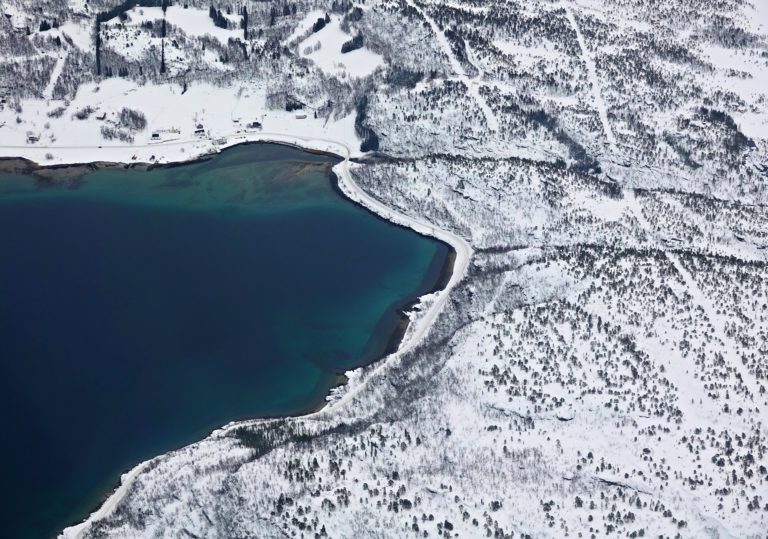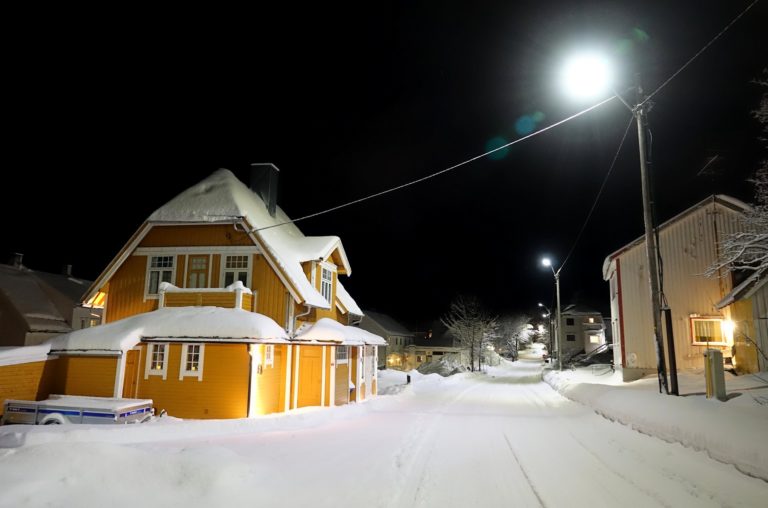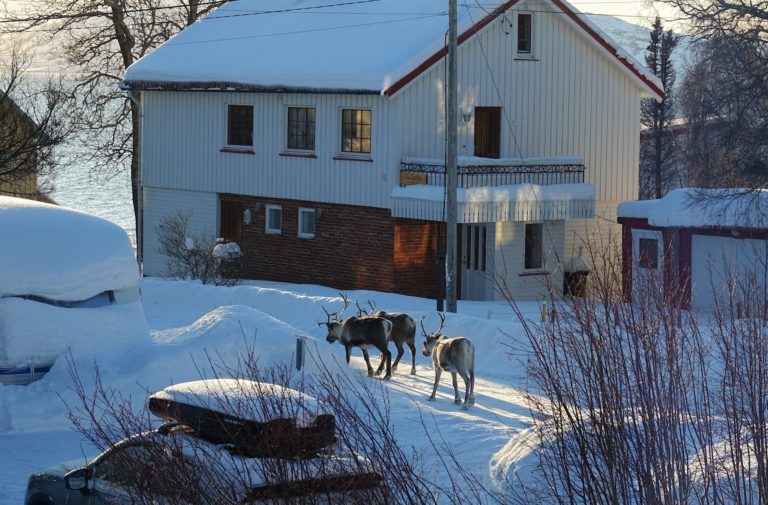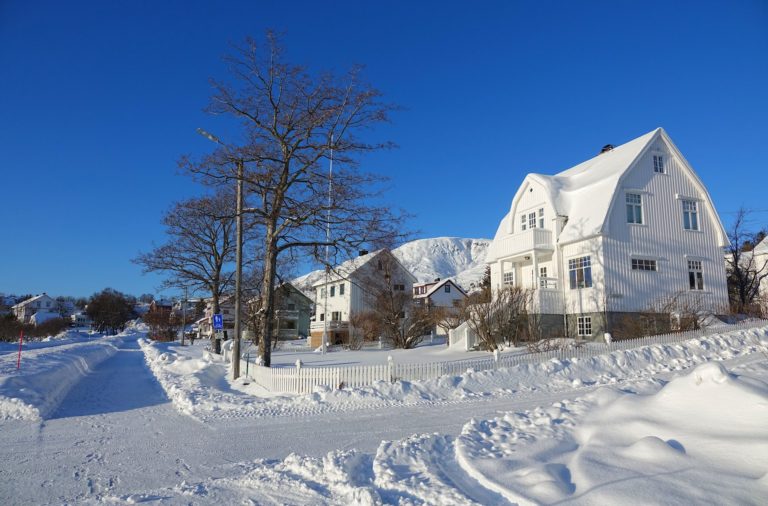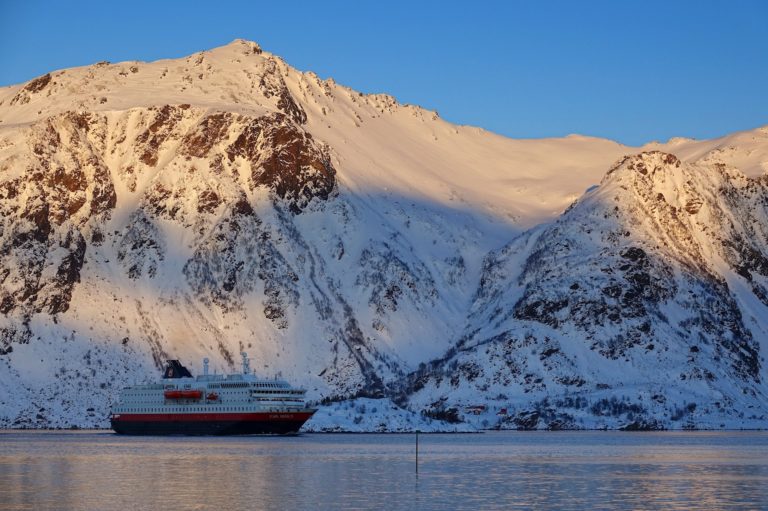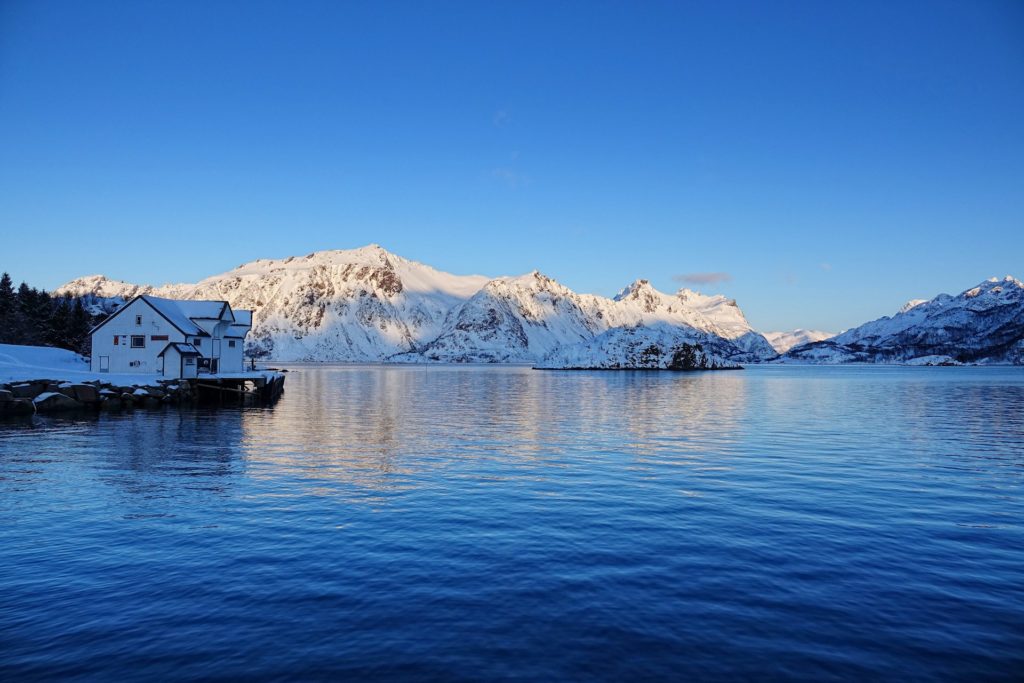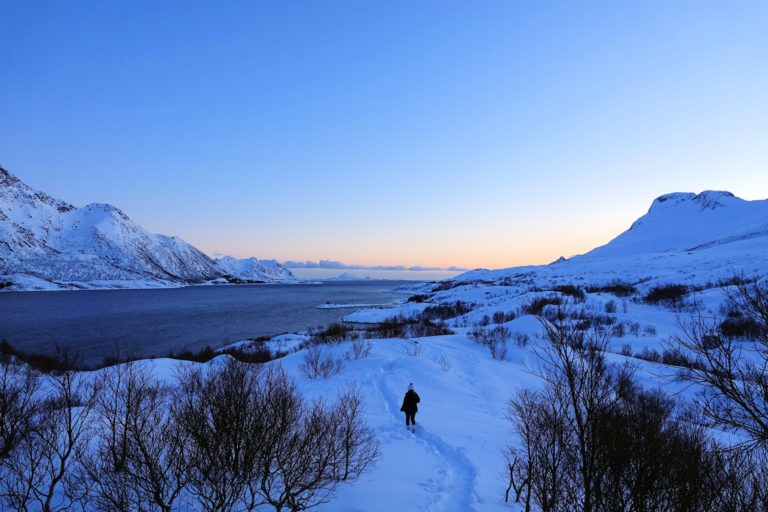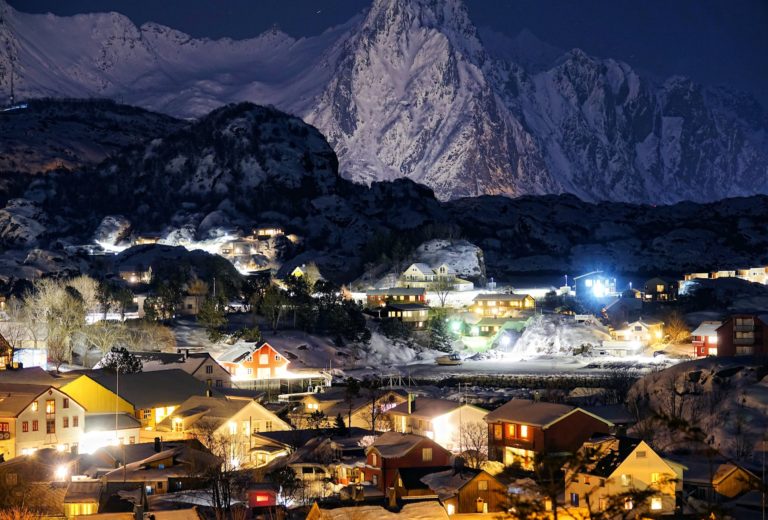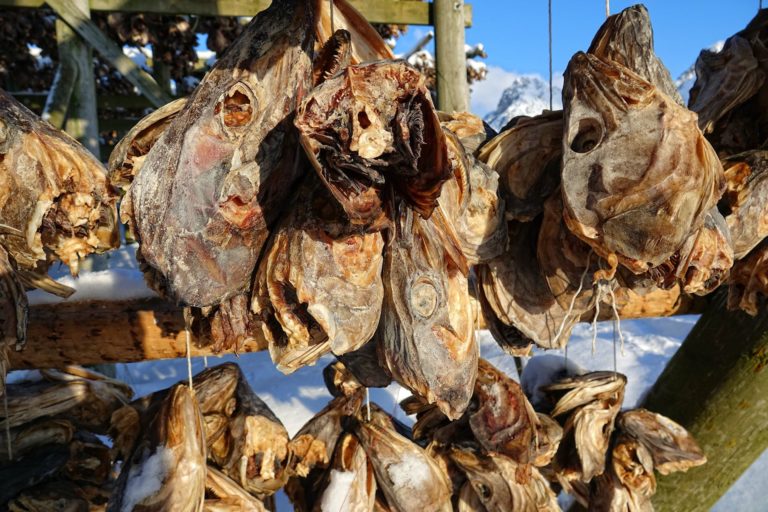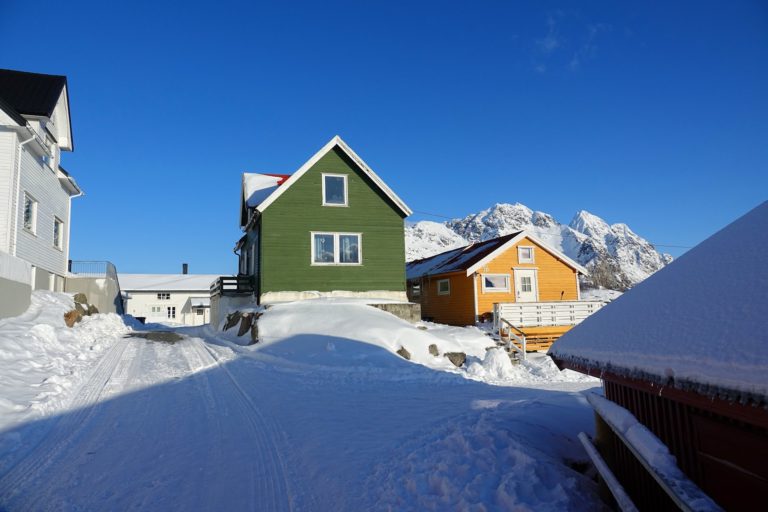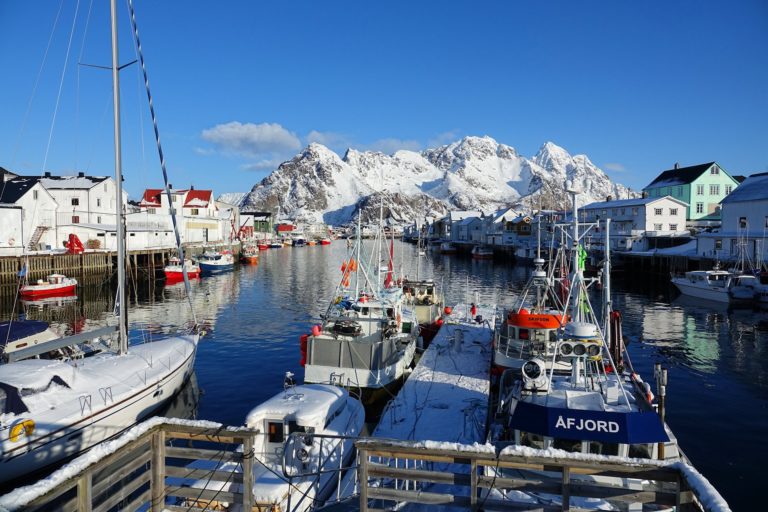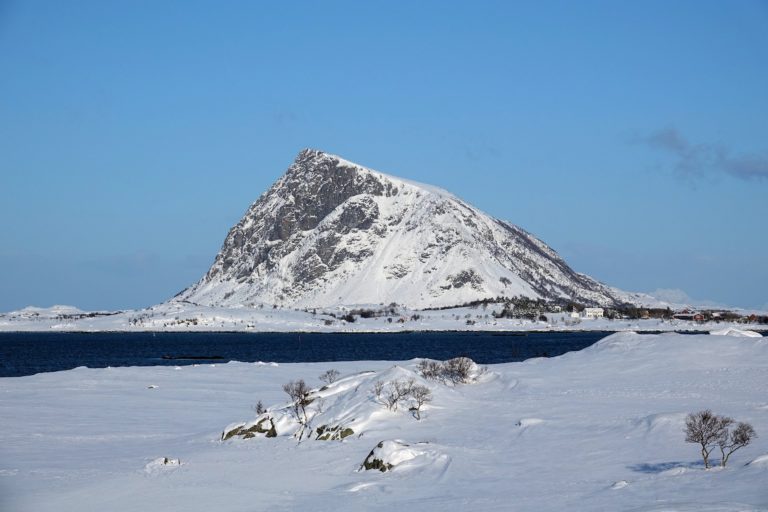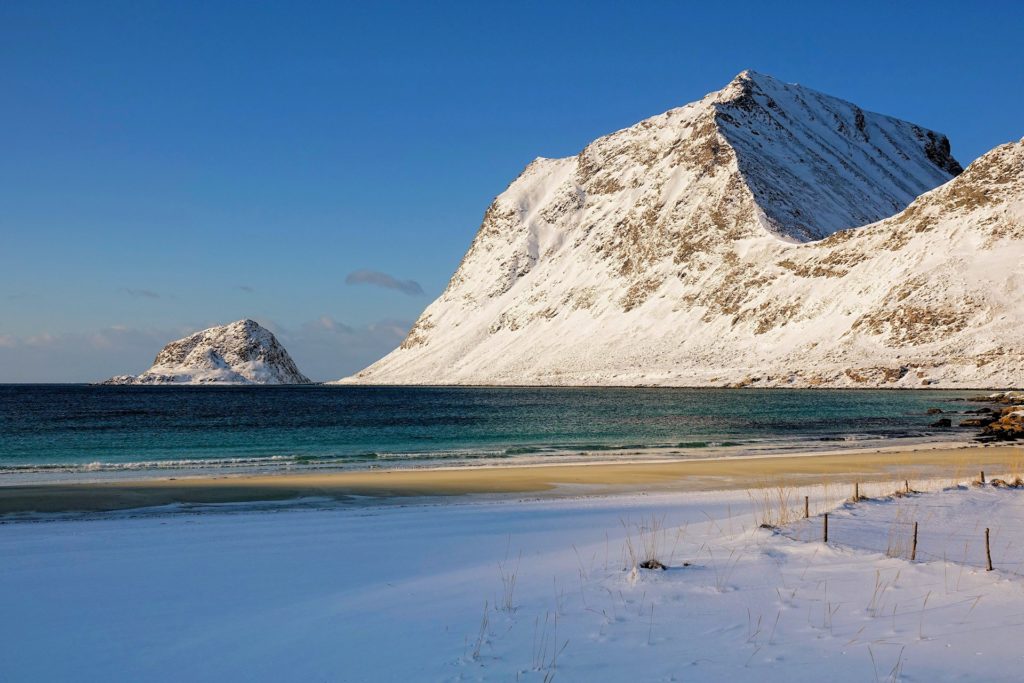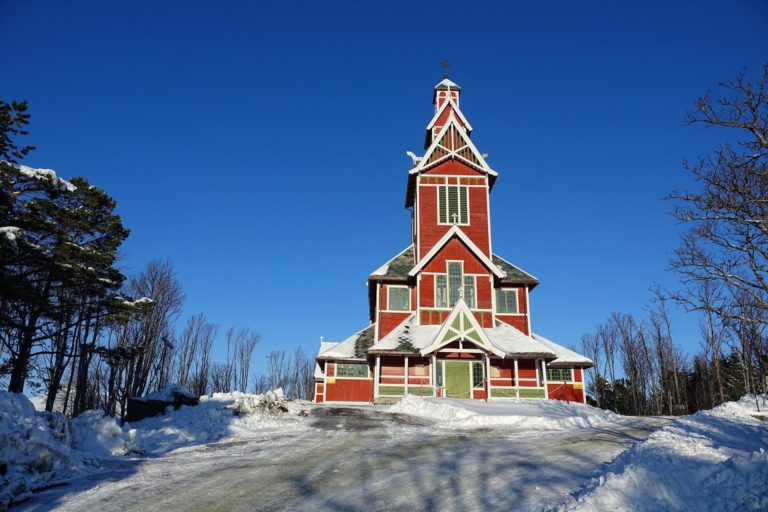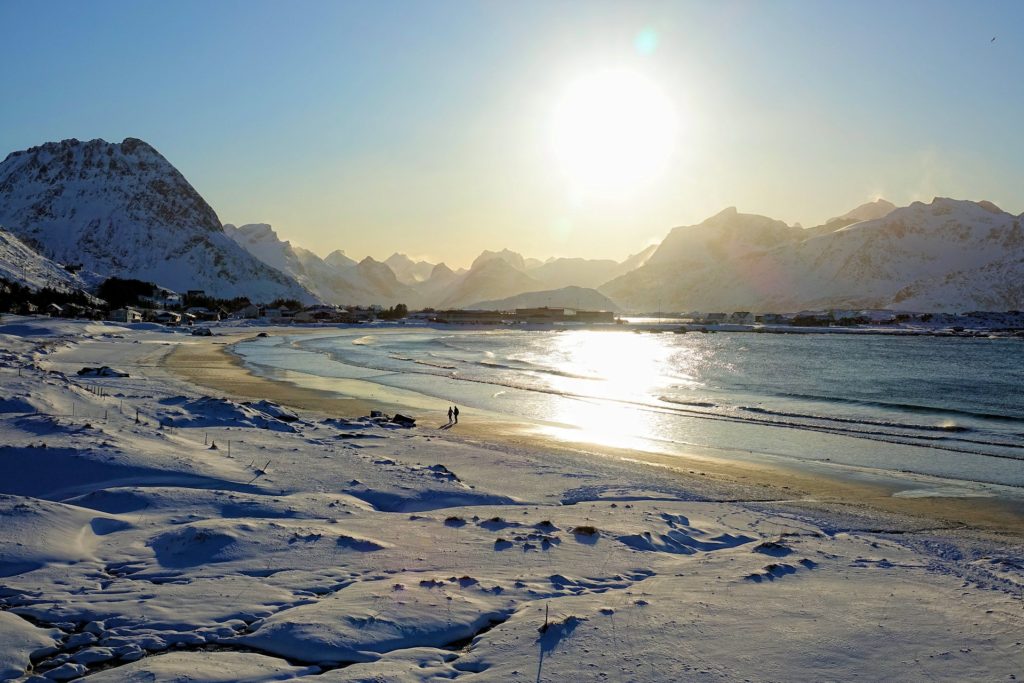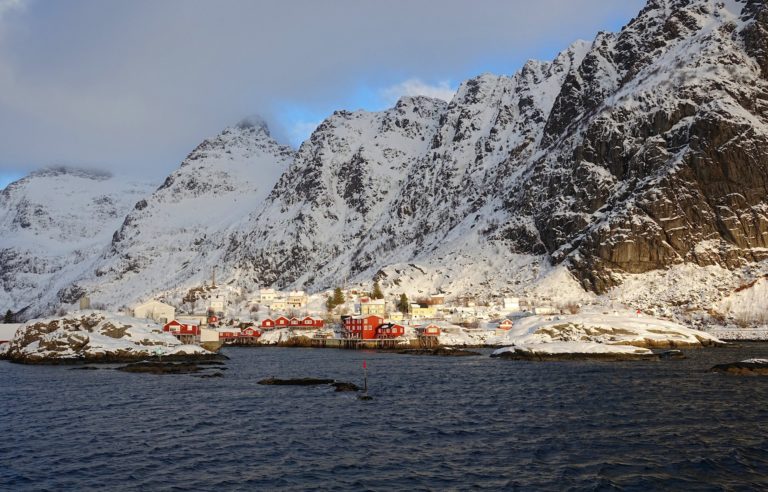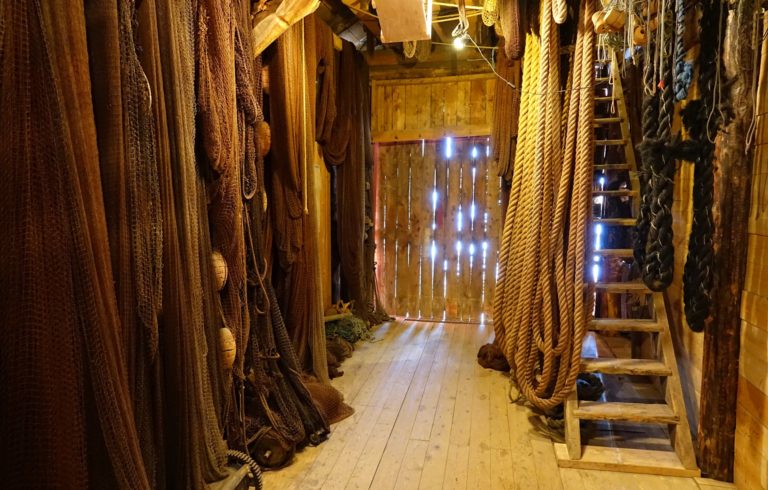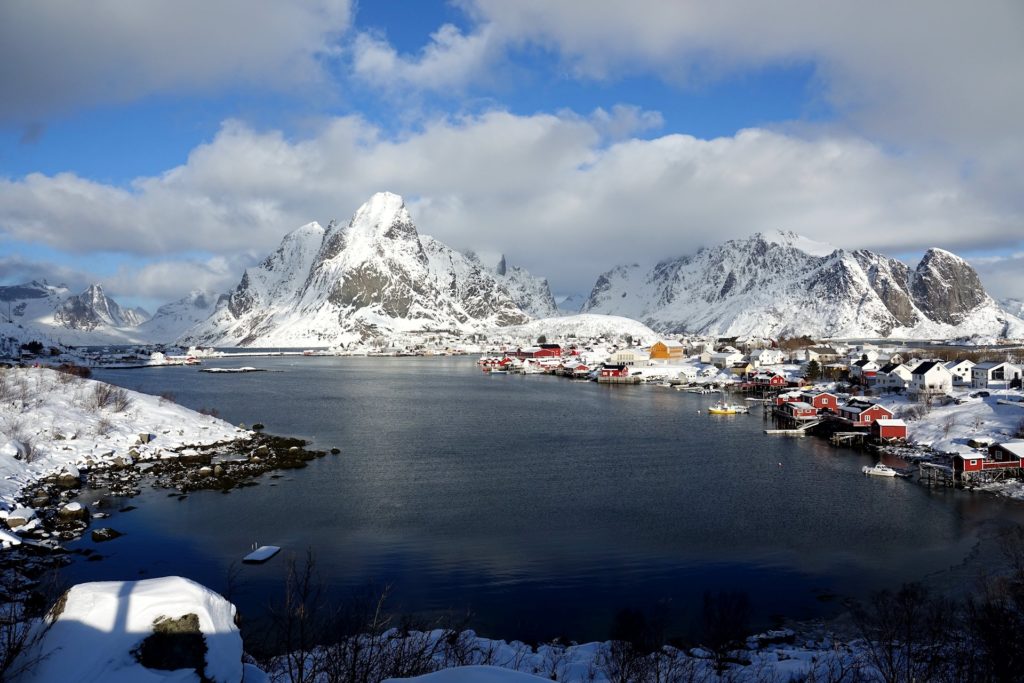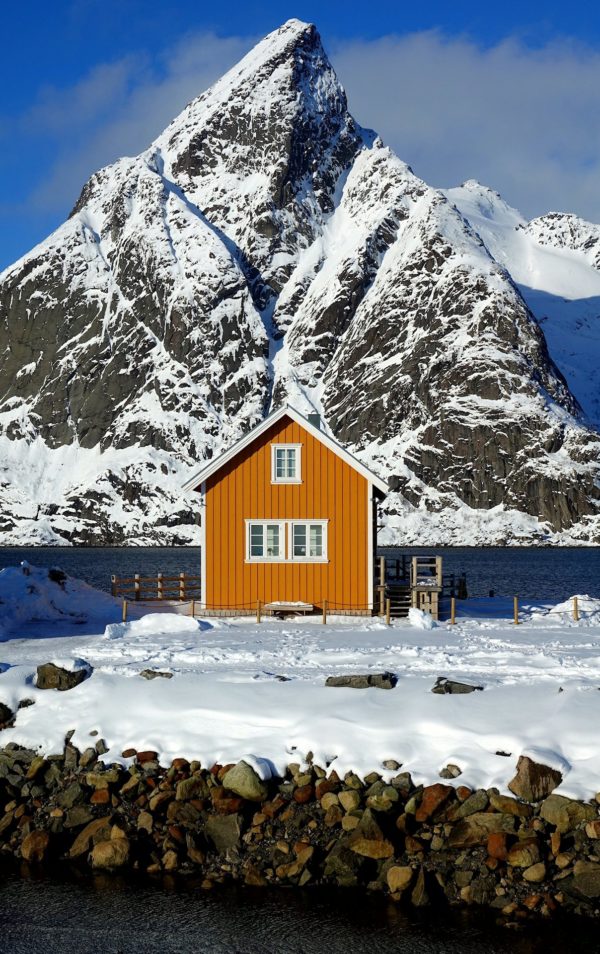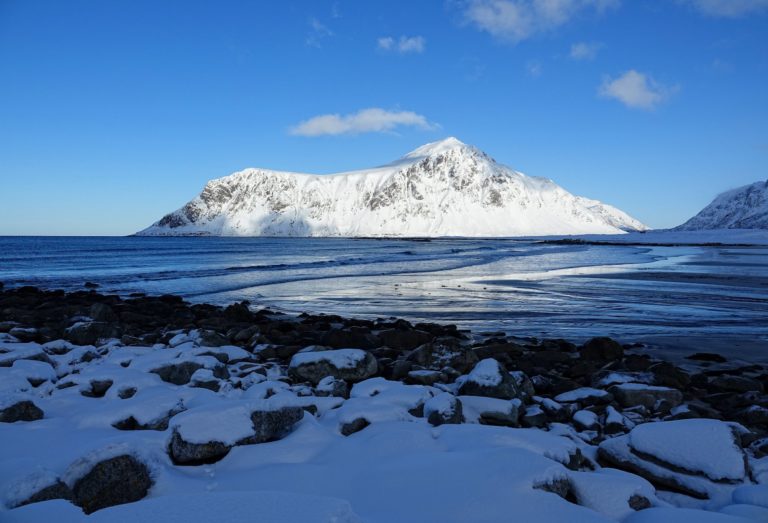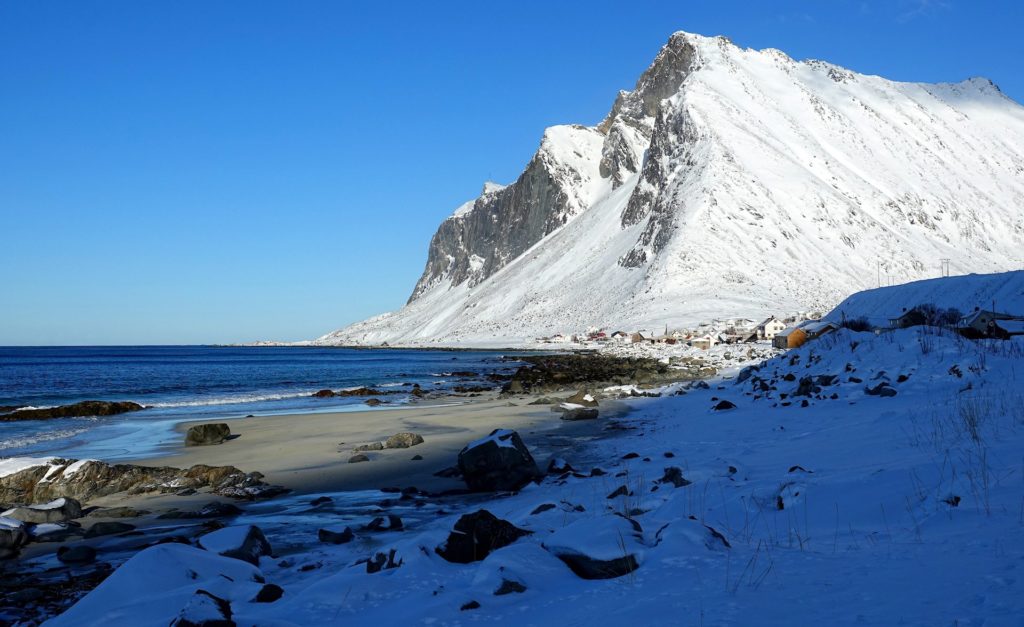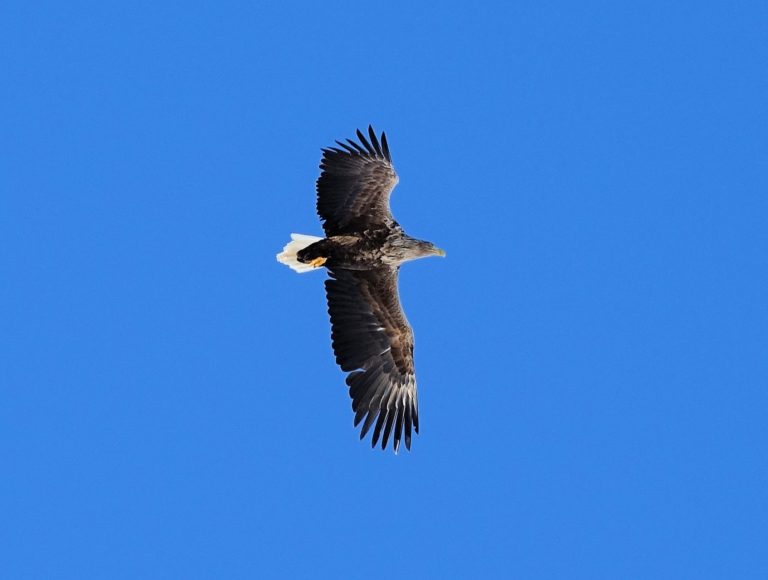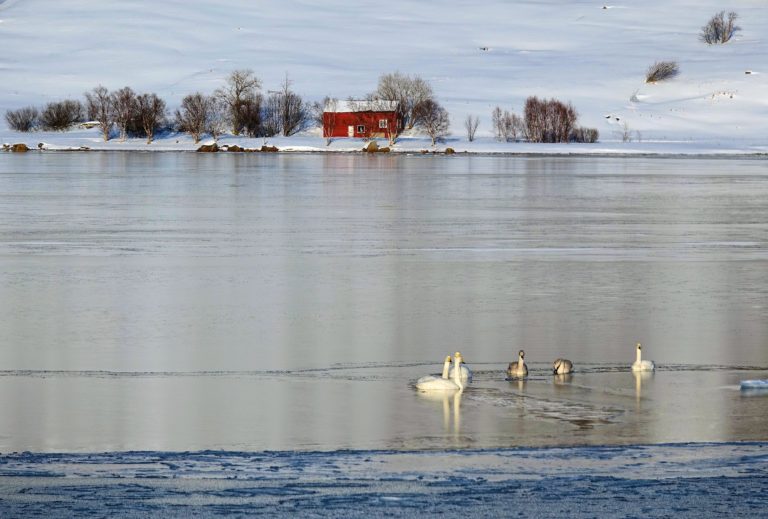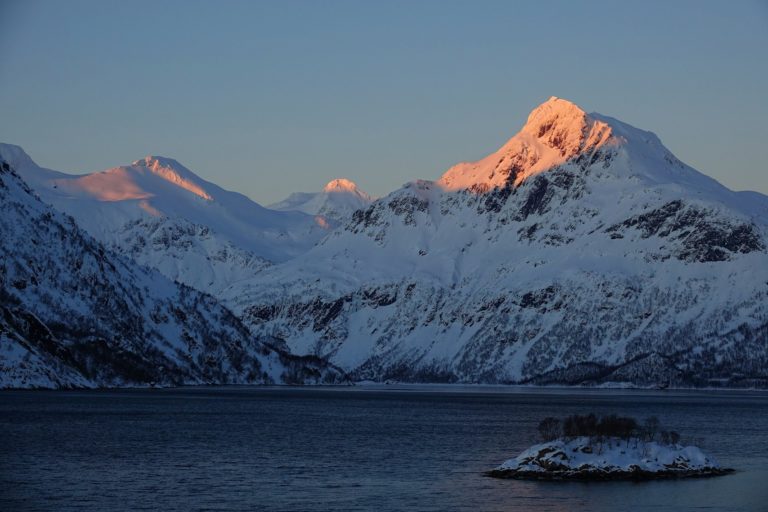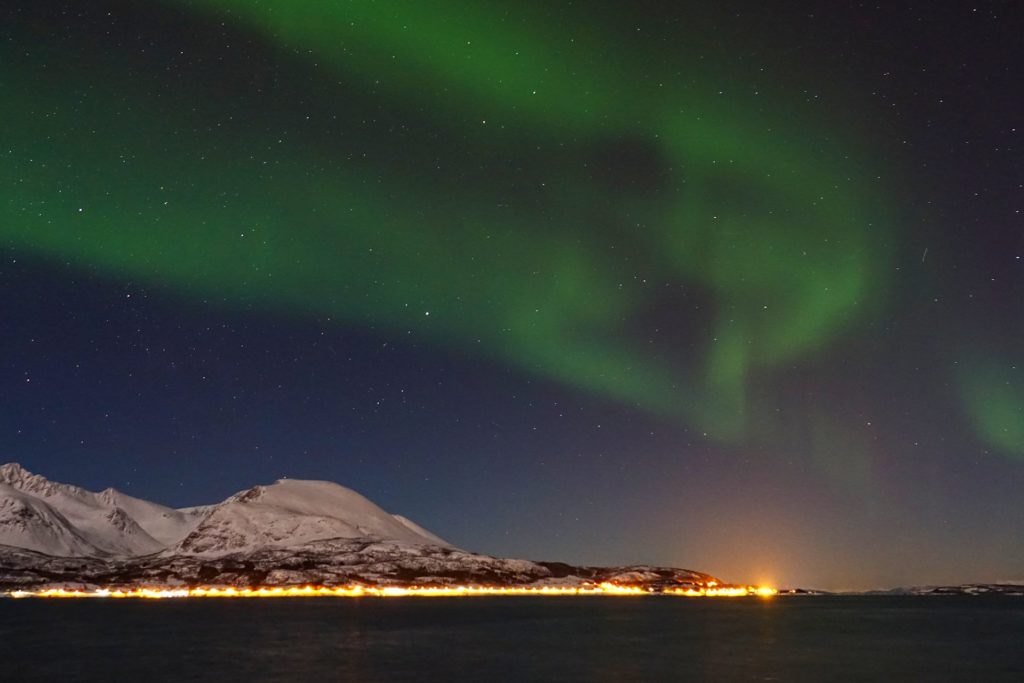The islands of Lofoten receive a massive tourist crowd every summer. If you go in the winter instead, you’ll be part of a much smaller herd. You’ll find the same views, only whiter, colder and only for a limited number of hours per day. This is the Arctic, after all. I’ll show you what a three day road trip through the archipelago may look like.
In the cover photo you see the main road through the islands, E10, just west of Svolvær. It’s a rare straight stretch on this road. Otherwise, the conditions shown here are fairly typical for this road. Your rental car will come with good tires, but you must always pay close attention to the surface you’re about to conquer.
We start our trip by flying for about two hours north from Oslo, to Harstad/Narvik airport. Every minute we’re in the air brings us deeper into winter.
Just as we’re about to land, we see the eternally cold North Atlantic Ocean below. Thanks to a relatively warm current stretching to here from the Gulf of Mexico, this coast has almost no ice. The sea itself looks similar to tropical waters, with lots of azure and green. However, the land next to it, covered in snow, means that there won’t be much swimming on this trip. Provided we manage to keep our car on the road, of course.
After picking up a rental car from the airport, we drive for an hour. It’s dark outside by the time we get to Lødingen, where we stay for the night.
It’s late February, and the days are evenly split between daylight, twilight and night. That’s a good mix. It means we get at least eight hours where it’s possible to observe the northern lights, and we also get about eight hours to fully enjoy a visible landscape.
Lødingen is a typical village of this region. It’s quiet, but has lots of atmosphere, especially when buried in fresh snow.
Because it’s technically not part of Lofoten, it gets few visitors. If it fits your schedule, it’s a relatively cheap place to stay for the night, and you’ll be all set for entering Lofoten proper early on the next day.
Although it lacks the dramatic mountains of Lofoten, Lødingen is still pretty, and just as far north. If there are northern lights in Lofoten, there are northern lights here.
We go outside to check, but only a few faint, green stripes flash across the sky before the clouds cover them all up. That’s the typical northern lights experience, but it’s enough to give us high hopes for the rest of the trip.
Before we leave Lødingen, we go for a walk to explore. There are no other people outside, but we’re not alone.
A group of reindeer is roaming around. They’re not afraid of us, but they seem a bit annoyed by us daring to disturb their morning walk.
A majority of the houses here are painted bright white. The heavy dose of winter that has fallen here recently makes them particularly pretty.
While Norway in general is an expensive place to live, you can buy a decent house here for as little as USD 100,000.
We start driving the E10, and it’s glorious.
This is the mountain Kongsviktinden, with two colorful buildings at its base. Colors like these are hard to miss in this wintery landscape. It certainly makes them somewhat easier to spot in a blizzard.
Near to where Lofoten officially begins, we drive past Seborfjellet and Møysalen National Park. These are great mountains for hiking in the summer. In February, it’s better and safer to look up at them than down from them.
At Raftsundet we stop to take in the view. A frequent visitor to the area nicely complements the scenery. This ship or one of her Hurtigruten sisters will come through here exactly once a day in each direction, all year round, come sunshine or crazy storm.
Hurtigruten is an alternative to driving through Lofoten. It’s a peculiar mix of cruise ship and freight vessel, endlessly traveling via 36 ports of call between Bergen in the south of Norway, and Kirkenes, near the border to Russia. Five of the stops they make are in the Lofoten/Vesterålen archipelago; Stamsund, Svolvær, Stokmarknes, Sortland and Risøyhamn. The Stamsund – Risøyhamn trip lasts about eight hours, and gives you an incredible amount of scenery for about USD 100.
The bluest view, north from the Hanøy ferry landing, towards the mountains of Vesterålen.
One underwater tunnel later, we surface on the island of Austvågøya, where the Higravtindan mountains line up along the fjord.
A warm shade of red is fading high up on the mountain. Apart from that, everything looks uncomfortably cold. We’re definitely in Lofoten now.
During summer, Lofoten will tempt you to stop the car and get out and take in the view all the time. Now, however, the road is surrounded by walls of snow, so we can only make stops at various maintained official viewpoints. There aren’t many tourists around, but there are enough of us to keep the trail up to the viewpoint at the Austnesfjorden rest stop navigable.
The sun sets while we’re here, but it’s okay. Our goal for the day is Svolvær, a town just behind and below that peak on the right side. Frozen toes is no problem when you know there’s a hot shower ahead.
Svolvær is the largest town in Lofoten, and full of soul-less modern buildings. So for tonight’s hunt for the northern lights, we drive a few kilometres further west. Here we find Kabelvåg, a much smaller and cozier place for an evening stroll.
We head up to Breidablikk, “Wide-view”, a hill in the middle of Kabelvåg. No green waves in the sky tonight, but what we can see from here is worth the short climb anyway.
It’s the middle of the Lofoten fishing season. Huge numbers of Arctic cod come close to land to spawn. It’s the richest fishing on this planet, thanks to heavy regulation.
Relatively small boats go out early in the morning, almost guaranteed to return with a fortune in their hold. There are a lot of grinning men in Svolvær these days.
It may sound like a Nigeria scam in reverse, but much of the money made from the Lofoten fishery comes from exporting dried cod heads to Africa. You see the heads hanging to dry in open air for several months all over Lofoten, before it’s sent off to faraway lands.
The seagulls will leave the fish alone, preferring instead to feast on the far more nutritious fish entrails that are easily available everywhere during fishing season. By the time that food source disappears, the hanging fish is so dry and hard that it’s no longer attractive to the birds.
To fully appreciate the rich colors of the houses in Lofoten, you really need to visit during winter. The intense, lush greenery of summer tends to drown out these delightful visual screams.
Henningsvær is one of many -værs in Lofoten. A “vær” is a settlement of fishermen. They typically include a safe natural harbor, located close to rich fishing grounds.
Often it is only in recent times it has become possible to get to them by car, and even now it can be difficult, via narrow roads carved out of the mountain. But when you make it to Henningsvær, it feels like it’s worth the effort.
It’s a rare day when the Norwegian Sea is calm enough to allow reflections like this to occur.
You’re looking at the view north from the island Austvågøya towards Gimsøya and Vestvågøya. It seems that every place has a most wonderful name around here, adding tremendously to the fairytale atmosphere.
This knob of a mountain, Hoven, stands alone a bit away from the others, so it’s a great viewpoint for admiring the beaches and peaks of Lofoten.
At its base there’s a golf course, so in summer you can come here and play midnight golf.
We make a detour north from the main road before Leknes, to drive towards Uttakleiv. This small road takes us past some gorgeous beaches.
Both the sand and the sea looks sooo inviting, but this place is as freezing cold as anywhere else in Lofoten today.
That mountain is simply called Veggen, “The Wall”. There’s a perfectly fine trail you can hike up on the other side of it.
An almost 900 meters long tunnel takes us the last bit to Uttakleiv.
Until 1998, the 22 souls that live here had to use a dangerous road, prone to avalanches and rock slides every time they wanted to travel to or from the nearest town. So Norway built them an expensive tunnel, and now the old road is a popular hike instead.
The world is a funny place.
At first glance it may appear that we have found Santa’s workshop, but it turns out to be Buksnes church.
Fishermen sure like having their buildings painted in vivid colors.
The white sandy beach at Ramberg, with a Hawaii-like mountain backdrop, frequently appears on lists of the most beautiful beaches in Norway. I’m not sure it can quite match many of the beaches in Lofoten that are less accessible, but it’s a great place to stop your car and go for a walk.
The rental car we use is a Toyoto Rav4 2.0 Automatic, and this SUV is a steady ride on a sometimes challenging road. We paid 4600 Norwegian kroner (roughly 460 US dollars) for one week, renting from Avis.
Some of the Instagram hotspots of Lofoten can get crowded even in the middle of the winter.
Here’s a typical group of photography course travelers, all lined up to take probably the exact same photo that once inspired them to come here. They’re standing in front of the scenic village of Reine, almost entirely surrounded by steep mountains.
At last we reach the village at the end of the road through Lofoten, Å.
The name is quite fitting. Å is also the last letter in the Norwegian alphabet. Our prize for getting here is a decent show of northern lights. Success!
We stay at a hostel on top of the stockfish museum in Å, located in the large red building in the center of this photo.
If you ever want to go see a stockfish museum, it should definitely be this one. Mainly because it’s your only option on this planet. The hostel is not great, but okay, and certainly a welcome alternative in an area where rooms usually come with a high price tag. Camping is a good alternative during the summer, but in March you want some walls around you.
Å has fewer inhabitants than it used to, but those who stayed behind are a pragmatic bunch of people.
Half the village is now simply the Norwegian Fishing Village Museum. There’s an old bakery, a boat house, a post office, a traditional home, a cod liver oil factory, and more. If you wonder what the many abandoned old houses you’ve been driving past on your way here look like inside, this is a good place to find out.
Beyond Å, you must travel by ferry to get to the last couple of island communities, Værøy and Røst. We’re not doing that, so we must drive back the way we came.
That’s fine. Going the other way feels like entering a vaguely familiar, yet still new and exciting world. This is the view back at Reine again. It looks different now at noon than it did late in the afternoon when we were here yesterday.
We cross over to the other side of the Bay of Reine, looking at the village from the east, on Olenilsøya.
The ridge behind the village is Reinebringen, and if you’ve ever seen photos from Lofoten before, you will have seen at least one taken from that mountain. A great steep trail leads up there, recently built by skilled Nepalese sherpas.
On Sakrisøya, architecture imitates nature.
The Matterhorn-like tobleronic mountain in the background is Olstinden, 675 meters high.
One does not simply walk up Olstinden.
Especially not during winter.
Another tunnel, one and a half kilometer long, takes us straight through the mountain Lilandstinden.
Flakstad beach is yet another good place to stop and look around. This place is actually a popular almost year-round destination for hard-core surfers. Lofoten Beach Camp does surf board rentals. I recommend getting a wet suit with that surf board.
We get a lot of this kind of view on our road trip; standing on a beach in the shadow of some mountain, looking across water to a brilliantly sunlit mountainside. It looks nice over there, so we decide to drive that way.
Behind the mountain on the last photo, there’s of course another mountain, with another hamlet below, Vikten.
This is one rugged location, with the open ocean right next door. I doubt anyone in the world has fresher air in their lungs than we do here and now.
The Lofoten wildlife is mainly limited to what lives in the ocean. The main predator here is therefore the white-tailed eagle, which happily preys on the fish buffet.
These giant birds often soar past us whenever we stop for a view.
Another pretty little village, Steira, below Limstrandtinden.
You sometimes have to stop and wonder how many generations of experiments it took before the people who live here decided what would be a sufficiently safe place to build their homes.
A flock of whooper swans, stretching their species’ wintering range by being in Lofoten in March.
It doesn’t look like they have a lot to eat, but I guess they prefer the scenery here, just like us.
Just as we leave Lofoten, the last few rays of sunlight on this trip hit this mountain.
We’ve had a great time, driving west from Lødingen for two days and back east in one long day.
It would have been easy to fill another day or two by taking more of the many detours one can choose between, instead of rushing back. But there’s increasing talk about new travel restrictions due to some mysterious Corona virus outbreak.
No matter how wonderful this area is, we decide that we don’t want to risk getting stuck here.
For the last night of our trip, we sleep in Harstad, the third largest town in Northern Norway, a forty minute drive north of the airport.
Despite the light pollution here, we are able to enjoy a good view of the northern lights from the ferry landing at Stornes, just outside Harstad.
We’re happy now. I hope you are, too.
Travel Tips
Transportation
Lofoten is such a parade of stunning views. To enjoy it fully, you’ll need to either walk it, bike it, or rent your own car. If none of those options appeal to you, buses can also take you to all the main towns and villages in the archipelago.
Public transportation can be a good deal. There’s a travel pass that allows unlimited travel on all buses and speedboats in all of Nordland county for a full week for just 990 Norwegian kroner, roughly 100 US dollars.
Nordland is a large county, roughly the size of Switzerland or the Netherlands, so you can use this option to travel from Brønnøysund in the south all the way to Andøya, well north of Lofoten. Check out the Travel Pass Nordland.
The starting point we chose, Harstad/Narvik airport, is often the cheapest way to fly in from southern Norway. Especially if you want to combine Lofoten with excellent skiing in Narvik, or maybe a quick side quest into Swedish Lapland, parts of which are also quite scenic, believe it or not.
Another good way to begin is by flying to Svolvær. It’s right in the middle of the Lofoten area, but keep in mind that flying there may cost quite a bit more.
Both these airports offer good car rental options, as long as you book in advance at a rate you’re happy with.
Accommodation
We stayed at these places, and I’m happy to recommend all three of them:
- Svolvær: Scandic Vestfjord Lofoten, a full service hotel with great breakfast and location
- Å: Lofoten Å HI Hostel, a basic hostel at the end of the world of Lofoten. Bring the food you need, the only shop in Å is at the fishing village museum.
- Harstad: F2 Hotel, an inexpensive self-service hotel in downtown Harstad. There’s no reception, you check yourself in via a code you receive by SMS or e-mail.
